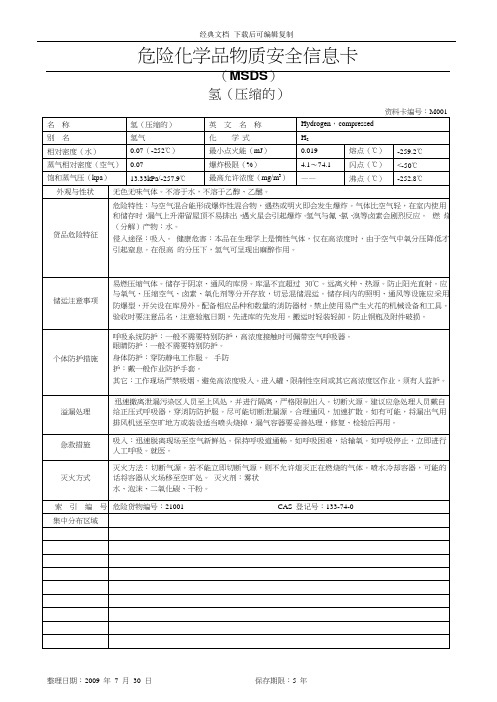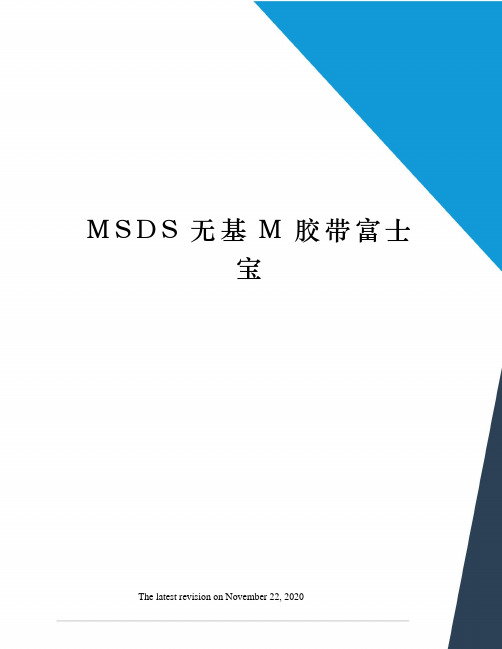MSDS-SMP.doc零水
- 格式:doc
- 大小:47.50 KB
- 文档页数:6

无水对氨基苯磺酸MSDS无水对氨基苯磺酸化学品安全技术说明书说明书目录第一部分化学品名称第九部分理化特性第二部分成分/组成信息第十部分稳定性和反应活性第三部分危险性概述第十一部分毒理学资料第四部分急救措施第十二部分生态学资料第五部分消防措施第十三部分废弃处理第六部分泄漏应急处理第十四部分运输信息第七部分操作处置与储存第十五部分法规信息第八部分接触控制/个体防护第十六部分其它信息第一部分:化学品名称化学品中文名称:无水对氨基苯磺酸;磺胺酸化学品英文名称:p-Aminobenzene sulfonic acid中文俗名或商品名:Synonyms:CAS No.:121-57-3分子式:C6H7NO3S分子量:173.2第二部分:成分/组成信息纯化学品混合物化学品名称:对氨基苯磺酸;磺胺酸第三部分:危险性概述危险性类别:侵入途径:吸入食入健康危害:摄入、吸入或经皮肤吸收后对身体有害。
具刺激作用。
环境危害:对环境有危害,对水体和大气可造成污染。
燃爆危险:本品不燃,具刺激性。
第四部分:急救措施皮肤接触:脱去污染的衣着,用肥皂水及清水彻底冲洗。
眼睛接触:立即翻开上下眼睑,用流动清水冲洗15分钟。
就医。
吸入:脱离现场至空气新鲜处。
呼吸困难时给输氧。
呼吸停止时,立即进行人工呼吸。
就医。
食入:误服者漱口,给饮牛奶或蛋清,就医。
第五部分:消防措施危险特性:受热分解,放出氮、硫的氧化物等毒性气体。
有害燃烧产物:一氧化碳、二氧化碳、硫化物、氧化氮。
灭火方法及灭火剂:雾状水、泡沫、二氧化碳、干粉、砂土。
消防员的个体防护:消防人员必须穿全身防火防毒服,在上风向灭火。
灭火时尽可能将容器。
从火场移至空旷处。
禁止使用的灭火剂:闪点(℃):无意义自燃温度(℃):引燃温度(℃):无意义爆炸下限[%(V/V)]:无意义爆炸上限[%(V/V)]:无意义最小点火能(mJ):爆燃点:爆速:最大燃爆压力(MPa):建规火险分级:第六部分:泄漏应急处理迅速撤离泄露污染区人员至安全区,并进行隔离,严格限制出入。

氢(压缩的)
一氧化碳
硫化氢
甲烷
丙烯
1,3-丁二烯
1,3-戊二烯
环氧乙烷
液化石油气
氧(压缩的)
氮(压缩的)
二氧化碳
氯化氢(无水)
氯(液化的)
氨
溴化氢
二氧化硫
四氟化硅
溴甲烷
汽油
危险化学品物质安全信息卡
(MSDS)
环戊烯
危险化学品物质安全信息卡
(MSDS)
2-甲基-1,3-丁二烯
危险化学品物质安全信息卡
(MSDS)
丙酮
危险化学品物质安全信息卡
(MSDS)
1,2-环氧丙烷
四氢呋喃
碳五
石油醚
石脑油
危险化学品物质安全信息卡
(MSDS)
1,2-二氯乙烷
危险化学品物质安全信息卡
(MSDS)
苯
甲基苯
乙基苯
甲醇
乙醇
1-丙醇
2-丙醇
2-甲基-2-丙醇
小
2-丁酮
2-戊酮
危险化学品物质安全信息卡
(MSDS)
甲基异丁基甲酮
危险化学品物质安全信息卡
(MSDS)
甲基叔丁基醚
危险化学品物质安全信息卡
(MSDS)
2,2-二甲氧基丙烷
吡啶
乙酸乙酯
乙酸丁酯
乙酸乙烯酯
丙烯酸甲酯(抑制了的)
丙烯酸乙酯
甲基丙烯酸甲酯
钛酸(四)异丙酯。

MSDS环保报告范本1. 引言本文是一份MSDS(材料安全数据表)环保报告范本。
该报告旨在提供有关特定材料的环境影响和安全性的信息,帮助用户了解和评估该材料的可持续性和环境友好性。
2. 材料基本信息2.1 材料名称在这里填写材料的名称。
2.2 制造商信息在这里填写材料制造商的名称、地址和联系方式。
2.3 材料成分在这里详细列出材料的成分和含量,并指明是否存在有害物质。
3. 环境影响评估3.1 降解性能描述该材料在自然环境中的降解性能。
如果该材料可降解,说明其降解过程和时间。
3.2 毒性评估评估该材料对环境和生物的毒性影响。
包括但不限于水生生物毒性、空气污染物的释放等。
3.3 生态风险评估评估该材料对生态系统的潜在风险。
分析其在生态系统中的积累和生物放大效应。
3.4 环境处理建议提供对该材料在使用过程中的环境处理建议,包括合理的处理方法和建议的废弃处理方式。
4. 安全性评估4.1 火灾危险性评估该材料的火灾危险性,包括燃烧性能、火灾逃生指南等。
4.2 健康危害评估该材料对人体健康的危害性,包括吸入、接触和摄入的相关风险。
4.3 个体防护措施提供在使用该材料时的个体防护建议,包括使用个人防护装备和采取适当的工作措施。
4.4 应急处置措施提供应急情况下的处置建议,包括泄漏处理、事故应对和紧急救援措施。
5. 合规性与认证5.1 法规合规性列出适用的法律法规和标准,确保该材料符合相关法律法规的要求。
5.2 认证标准列出该材料获得的任何环保认证或标准符合性证书。
6. 结论总结该材料的环境影响和安全性评估结果,并指出应用该材料的潜在风险和建议。
7. 参考文献列出所有在编写本报告中使用的参考文献。
以上是一份MSDS环保报告范本,用于提供特定材料的环境影响和安全性信息。
请根据实际情况,填写相关信息,以编写适用于您的材料的环保报告。

化学安全技术文档(水性涂料-MSDS)1. 产品标识- 产品名称:水性涂料- 产品代码:根据具体情况填写- 制造商:根据具体情况填写- 紧急电话:根据具体情况填写2. 成分/组成信息- 化学名称:根据具体情况填写- CAS号:根据具体情况填写- 含量:根据具体情况填写3. 危险性概述- 涉及危害:根据具体情况填写- 急性毒性:根据具体情况填写- 慢性健康危害:根据具体情况填写- 环境危害:根据具体情况填写4. 急救措施- 吸入:根据具体情况填写- 眼部接触:根据具体情况填写- 皮肤接触:根据具体情况填写- 食入:根据具体情况填写- 注意事项:根据具体情况填写5. 消防措施- 灭火剂:根据具体情况填写- 灭火注意事项:根据具体情况填写- 防止燃烧扩散的措施:根据具体情况填写6. 泄漏应急处理- 个人防护措施:根据具体情况填写- 环境保护措施:根据具体情况填写- 泄漏清理方法:根据具体情况填写7. 操作处置和储存- 操作注意事项:根据具体情况填写- 储存要求:根据具体情况填写8. 暴露控制/个人防护- 工程控制:根据具体情况填写- 个人防护装备:根据具体情况填写9. 理化特性- 外观:根据具体情况填写- 气味:根据具体情况填写- 水溶性:根据具体情况填写- 熔点/熔融范围:根据具体情况填写- 相对密度:根据具体情况填写- 燃烧性:根据具体情况填写10. 稳定性和反应活性- 稳定性:根据具体情况填写- 可燃性:根据具体情况填写- 反应条件:根据具体情况填写- 避免的条件:根据具体情况填写11. 毒理学信息- 急性毒性:根据具体情况填写- 慢性毒性:根据具体情况填写- 致癌性:根据具体情况填写- 生殖毒性:根据具体情况填写12. 生态学信息- 生态毒性:根据具体情况填写- 水生生物毒性:根据具体情况填写13. 废弃物处理- 废弃物处理方法:根据具体情况填写- 废弃物分类:根据具体情况填写- 废弃物标记:根据具体情况填写14. 运输信息- 运输分类:根据具体情况填写- 运输注意事项:根据具体情况填写15. 法规信息- 标签要求:根据具体情况填写- 安全防护措施:根据具体情况填写- 特殊标记:根据具体情况填写16. 其他信息- 其他重要信息:根据具体情况填写以上仅为水性涂料的化学安全技术文档(MSDS)的基本框架,具体内容需要根据产品的特性和制造商提供的信息进行填写。


化学品MSDS编制单位:建滔(常州)化工有限公司建滔(常州)石化码头有限公司编制部门:安环部编制日期: 2011年6月目录1、丙酮MSDS (4)2、甲醇MSDS (5)3、乙醇MSDS (6)4、甲基苯MSDS (7)5、苯乙烯MSDS (8)6、苯MSDS (9)7、2-丁酮MSDS (10)8、环己酮MSDS (11)9、乙酸乙酯MSDS (12)10、乙酸乙烯酯MSDS (13)11、三氯乙烯MSDS (14)12、三氯甲烷MSDS (15)13、苯酚MSDS (16)14、丙烯酸甲酯MSDS (17)15、乙基苯MSDS (18)16、乙二醇MSDS (19)17、2-丙醇(异丙醇)MSDS (20)18、正丁醇MSDS (21)19、邻二甲苯MSDS (22)20、间二甲苯MSDS (23)21、对二甲苯MSDS (24)22、乙酸MSDS (25)23、1,4-丁二醇MSDS (26)24、丙烯酸正丁酯MSDS (27)25、1-丙醇(正丙醇)MSDS (28)26、甲基丙烯酸甲酯MSDS (29)27、甲基叔丁基MSDS (30)28、乙二醇丁醚MSDS (31)29、1,2-二氯乙烷MSDS (32)30、1-壬烯MSDS (33)31、邻苯二甲酸二辛酯MSDS (34)32、四氯乙烯MSDS (35)33、甲基丙烯酸正丁酯MSDS (36)34、1,3-丙二醇MSDS (37)35、2-甲级丙醇(异丁醇)MSDS (38)36、溶剂油MSDS (39)37、汽油MSDS (40)38、柴油MSDS (41)39、环氧氯丙烷MSDS (42)40、煤油MSDS (43)41、辛醇MSDS (44)42、重油MSDS (45)43、丙二醇甲醚醋酸酯MSDS (46)44、甲醛MSDS...................................................... .. (47)1、丙酮MSDS3333333333。
化学品安全技术说明手册MSDS-T-26无水乙醇1.化学品及企业标识1.1化学品中文名:乙醇(无水)1.2化学品英文名:Ethanol1.3化学品别名:无水酒精1.4分子式:C2H6O2.危险性概述2.1紧急情况概述液体。
高度易燃,其蒸气与空气混合能形成爆炸性混合物。
2.2GHS危险性类别根据GB 30000-2013化学品分类和标签规范系列标准(参阅第十六部分),该产品分类如下:易燃液体,类别 2。
2.3标签要素2.3.1象形图2.3.2警示词:危险2.4危险信息:高度易燃液体和蒸气2.5防范说明2.5.1预防措施:远离热源、热表面、火花、明火以及其它点火源。
禁止吸烟。
保持容器密闭。
容器和接收设备接地和等势联接。
使用不产生火花的工具。
采取措施,防止静电放电。
戴防护手套/穿防护服/戴防护眼罩/戴防护面具。
2.5.2事故响应:如皮肤(或头发)沾染:立即去除/脱掉所有沾染的衣服。
用水清洗皮肤或淋浴2.5.3安全储存:存放处须加锁。
2.5.4废弃处置:按照地方/区域/国家/国际规章处置内装物/容器。
2.6危害描述2.6.1物理化学危险:高度易燃液体,其蒸气与空气混合能形成爆炸性混合物。
2.6.2健康危害吸入该物质可能会引起对健康有害的影响或呼吸道不适。
意外食入本品可能对个体健康有害。
通过割伤、擦伤或病变处进入血液,可能产生全身损伤的有害作用。
眼睛直接接触本品可导致暂时不适。
2.6.3环境危害本品对水生生物有毒。
请参阅MSDS第十二部分。
3.成分/组成信息4.急救措施4.1一般性建议:急救措施通常是需要的,请将本MSDS出示给到达现场的医生。
4.2皮肤接触:立即脱去污染的衣物。
用大量肥皂水和清水冲洗皮肤。
如有不适,就医。
4.3眼睛接触:用大量水彻底冲洗至少15分钟。
如有不适,就医。
4.4吸入:立即将患者移到新鲜空气处,保持呼吸畅通。
如果呼吸困难,给于吸氧。
如患者食入或吸入本物质,不得进行口对口人工呼吸。
QINGDAO YUANRUN CHEMICAL CO., LTD.MSDSMATERIAL SAFETY DATA SHEETTrade Name: Sodium Metasilicate PentahydrateDate Prepared: 09/06/20101.CHEMICAL PRODUCT AND COMPANY IDENTIFICATIONProduct name:Sodium Metasilicate, pentahydrateProduct description:Granular sodium metasilicate, pentahydrateManufacturer: QINGDAO DONGYUE SODIUM SILICATE CO. LTD.Company's P. O. Box:266041Company's City: QINGDAOCompany's State:SHANDONG PROVICECompany's Emerg Ph #:0086 532 84614618POSITION/INFORMATION ON INGREDIENTSChemical and Common Name CAS Registry Number Wt. %OSHA PEL ACGIH TLV Silicic acid, disodium salt; 6834-92-0 ~58% Not Established* Not Established* Disodium trioxosilicate;Sodium metasilicateWater 7732-18-5 ~42% Not Established Not Established * Manufacturer’s recommended exposure limit is 2 mg/m3 Ceiling Limit.3.HAZARDS IDENTIFICATIONEmergency Overview:White, odorless, granular powder. Corrosive to eyes, skin, and digestive tract. Dust corrosive to respiratory tract. Due to high pH of product, release into surface water is harmful to aquatic life. Noncombustible. Reacts with acids and some organics.Eye contact: Corrosive. Causes eye burns.Skin contact:Corrosive. Causes skin burns.Inhalation:Dust corrosive to respiratory tract.Ingestion:Corrosive. Causes burns to mouth, esophagus, and stomach.Chronic hazards: No known chronic hazards. Not listed by NTP, IARC or OSHA as a carcinogen. Physical hazards:Can etch glass if not promptly removed.4.FIRST AID MEASURESEye: In case of contact, immediately flush eyes with plenty of water for at least 15 minutes. Get medical attention immediately.Skin:In case of contact, immediately flush skin with plenty of water for at least 15 minutes while removing contaminated clothing and shoes. Get medical attention immediately. Wash clothing before reuse. Thoroughly clean shoes before reuse.Inhalation: Remove to fresh air. If not breathing, give artificial respiration. If breathing is difficult, give oxygen. Get medical attention.Ingestion: If swallowed, DO NOT induce vomiting. Get medical attention immediately. If victim is fully conscious, give a cupful of water. Never give anything by mouth to an unconscious person.5. FIRE FIGHTING MEASURESFlammable limits: This material is noncombustible.Extinguishing Media:This material is compatible with all extinguishing media.Hazards to fire-fighters:See Section 3 for information on hazards when this material is present in the area of a fire.Fire-fighting equipment: The following protective equipment for fire fighters is recommended when this material is present in the area of a fire: chemical goggles, body-covering protective clothing, chemical resistant gloves, and rubber boots.6. ACCIDENTAL RELEASE MEASURESPersonal protection:Wear chemical goggles, body-covering protective clothing, chemical resistant gloves, and rubber boots, NIOSH-approved dust respirator where dust occurs. See section 8. Environmental Hazards: Sinks and mixes with water. High pH of this material is harmful to aquatic life, see Section 12.Small spill cleanup: Carefully shovel or sweep up spilled material and place in suitable container. Avoid generating dust. Use appropriate Personal Protective Equipment (PPE). See section 8.Large spill cleanup: Keep unnecessary people away; isolate hazard area and deny entry. Do not touch or walk through spilled material. Carefully shovel or sweep up spilled material and place in suitablecontainer. Avoid generating dust. Use appropriate Personal Protective Equipment (PPE). See section 8. In case of contact with water, prevent runoff from entering into storm sewers and ditches which lead to natural waterways. Neutralize contaminated area and flush with large quantities of water. Comply with applicable environmental regulations.CERCLA RQ:There is no CERCLA Reportable Quantity for this material. If a spill goes off site, notification of state and local authorities is recommended.7. HANDLING AND STORAGEHandling:Do not get in eyes, on skin, or on clothing. Do not breathe dust. Keep container closed. Promptly clean up spills. Wash thoroughly after handling.Storage: Store at temperatures below 150ºF (65ºC). Keep containers closed. Store in clean, tightly closed steel, fiber, or plastic containers. Separate from acids, reactive metals, and ammonium salts. Do not store in aluminum, fiberglass, copper, brass, zinc or galvanized containers. This product can absorb water from the air. In case of high humidity or storage for extended periods of time, use plastic bags to enclose product containers to avoid caking. Packaged inventory should be used on a first in, first out (FIFO) basis. Bulk storage bins should be painted white or aluminum to minimize sun-heat absorption which can cause melting of this material at about 160ºF.8. EXPOSURE CONTROLS/PERSONAL PROTECTIONEngineering controls:Use only with adequate ventilation. Keep containers closed. Safety shower and eyewash fountain should be within direct access.Respiratory protection:Use a NIOSH-approved dust respirator where dust occurs. Observe OSHA regulations for respirator use (29 C.F.R. §1910.134)Skin protection:Wear body-covering protective clothing and gloves.Eye protection: Wear chemical goggles.9. PHYSICAL AND CHEMICAL PROPERTIESAppearance: Granular powder.Color: White.Odor: Odorless or musty odor.pH: 14 ApproximatelyBulk density: Approximately 49 lbs/ft3 untamped, 59 lbs/ft3 tamped.Solubility in water: Soluble.10.STABILITY AND REACTIVITYStability: This material is stable under all conditions of use and storage.Conditions to avoid: None.Materials to avoid:Generates heat when mixed with acid. May react with ammonium salt solutions resulting in evolution of ammonia gas. Flammable hydrogen gas may be produced on contact with aluminum, tin, lead, and zinc. Carbon monoxide gas may be produced on contact with reducing sugars. Hazardous decomposition Products: Hydrogen.11. TOXICOLOGICAL INFORMATIONAcute Data: This material has not been tested for primary eye irritation potential. However, on the basis of its high degree of alkalinity, it is regarded as corrosive to the eyes. When this material was tested for skin corrosion/irritation potential according to OECD Guidelines Section 404, it produced dermal corrosion. The acute oral toxicity of this product has not been tested. When sodium silicates were tested on a 100% solids basis, their single dose acute oral LD50 in rats ranged from 1500 mg/kg to 3200 mg/kg. The acute oral lethality resulted from nonspecific causes.Subchronic Data: In a study of rats fed sodium silicate in drinking water for three months, at 200, 600 and 1800 ppm, changes were reported in the blood chemistry of some animals, but no specific changes to the organs of the animals due to sodium silicate administration were observed in any of the dosage groups. Another study reported adverse effects to the kidneys of dogs fed sodium silicate in their diet at 2.4g/kg/day for 4 weeks, whereas rats fed the same dosage did not develop any treatment-related effects. Decreased numbers of births and survival to weaning was reported for rats fed sodium silicate in their drinking water at 600 and 1200 ppm.Special Studies:Sodium silicate was not mutagenic to the bacterium E. Coli when tested in a mutagenicity bioassay. There are no known reports of carcinogenicity of sodium silicates. Frequent ingestion over extended periods of time of gram quantities of silicates is associated with the formation kidney stones and other siliceous urinary calculi in humans. Sodium silicate is not listed by IARC, NTP or OSHA as a carcinogen.12. ECOLOGICAL INFORMATIONEco toxicity:The following data is reported for sodium silicates on a 100% solids basis: A 96 hour median tolerance for fish (Gambusia affnis) of 2320 ppm; a 96 hour median tolerance for water fleas(Daphnia magna) of 247 ppm; a 96 hour median tolerance for snail eggs (Lymnea) of 632 ppm; and a 96 hour median tolerance for Amphipoda of 160 ppm.Environmental Fate: This material is not persistent in aquatic systems, but its high pH when undiluted or unneutralized is acutely harmful to aquatic life. Diluted material yields dissolved silica in a form that is indistinguishable from natural dissolved silica. It does not contribute to BOD. This material does not bioaccumulate except in species that use silica as a structural material such as diatoms and siliceous sponges. Where abnormally low natural silica concentrations exist (less than 0.1 ppm), dissolved silica may be a limiting nutrient for diatoms and a few other aquatic algal species. However, the addition of excess dissolved silica over the limiting concentration will not stimulate the growth of diatom populations; their growth rate is independent of silica concentration once the limiting concentration is exceeded. Neither silica nor sodium will appreciably bioconcentrate up the food chain.Physical/Chemical: Sinks and dissolves in water.13. DISPOSAL CONSIDERATIONSClassification:Disposed dry/solid material is not classified as a RCRA Hazardous waste.However, disposed water/wet solutions containing this material are classified as RCRA hazardous waste if they exhibit the corrosive characteristic (pH greater than or equal to12.5) as defined in EPA rules at 40 C.F.R. §261.22 (a)(1).Disposal Method: Dispose in accordance with federal, state and local regulations.14. TRANSPORT INFORMATIONDOT UN Status: This material is a regulated hazardous material.UN PROPER SHIPPING NAME: Disodium trioxosilicateUN HAZARD CLASS/DIVISION:8UN IDENTIFICATION NUMBER: UN3253UN PACKING GROUP: PG III15. REGULATORY INFORMATIONCERCLA: No CERCLA Reportable Quantity has been established for this material.SARA TITLE III:Not an Extremely Hazardous Substance under §302. Not a Toxic Chemical under §313. Hazard Categories under §§311/312: AcuteTSCA: All ingredients of this material are listed on the TSCA inventory.FDA: The use of sodium metasilicate is authorized by FDA as a boiler water additive for the productionof steam that will contact food pursuant to 21 CFR §173.310; and as a GRAS substance pursuant to 21 CFR §184.1769afor use in washing and lye peeling of fruits, vegetables, and nuts; as a denuding agent for tripe; a hog scald agent in removing hair; and as a corrosion preventative in canned and bottled water. 16. OTHER INFORMATIONSupersedes revision of: 01/24/06THE INFORMATION ON THIS SAFETY DATA SHEET IS BELIEVED TO BE ACCURATE AND IT IS THE BEST INFORMATION AVAILABLE TO QINGDAO DONGYUE SODIUM SILICATE CO., LTD. THIS DOCUMENT IS INTENDED ONLY AS A GUIDE TO THE APPROPRIATE PRECAUTIONS FOR HANDLING A CHEMICAL BY A PERSON TRAINED IN CHEMICAL HANDLING. QINGDAO DONGYUE SODIUM SILICATE CO., LTD MAKES NO WARRANTY OF MERCHANTABILITY OR ANY OTHER WARRANTY, EXPRESS OR IMPLIED WITH RESPECT TO SUCH INFORMATION OR THE PRODUCT TO WHICH IT RELATES, AND WE ASSUME NO LIABILITY RESULTING FROM THE USE OR HANDLING OF THE PRODUCT TO WHICH THIS SAFETY DATA SHEET RELATES. USERS AND HANDLERS OF THIS PRODUCT SHOULD MAKE THEIR OWN INVESTIGATIONS TO DETERMINE THE SUITABILITY OF THE INFORMATION PROVIDED HEREIN FOR THEIR OWN PURPOSES.THE END。